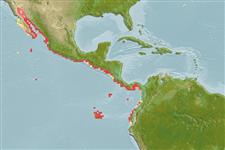>
Eupercaria/misc (Various families in series Eupercaria) >
Labridae (Wrasses) > Corinae
Etymology: Halichoeres: Greek, als, alis = salt + Greek, choiros = pig (Ref. 45335).
More on authors: Jordan & Gilbert.
Environment: milieu / climate zone / depth range / distribution range
Ecologia
marino associati a barriera corallina; distribuzione batimetrica 3 - 53 m (Ref. 9311), usually 3 - 27 m (Ref. 9311). Tropical; 32°N - 1°S
Eastern Pacific: Gulf of California to Panama, including the Galapagos Islands.
Size / Peso / Age
Maturity: Lm ? range ? - ? cm
Max length : 38.0 cm TL maschio/sesso non determinato; (Ref. 9311); common length : 20.0 cm TL maschio/sesso non determinato; (Ref. 55763)
Short description
Chiavi di identificazione | Morfologia | Morfometria
Body moderately slender and compressed; head somewhat small and pointed; teeth caniniform, enlarged, and somewhat crooked, two anterior pairs in each jaw; posterior end of upper jaw with one protruding, forward directed canine on each side; dorsal fin continuous, with 9 spines; lateral line with 28 scales; body blue green, with a dark, vertical bar near posterior edge of pectoral fin, preceded by a very marked yellow spot; all fins except pectorals, blue, speckled with red or light colored spots and stripes (Ref. 55763).
Found over sand and gravel bottoms near coral reefs. Adults are solitary but juveniles form aggregations, sometimes with other species of wrasses. Feeds on mollusks, brittle stars, sea urchins and crabs. Hides under the sand to sleep and to seek shelter, in cases of danger.
Life cycle and mating behavior
Maturities | Riproduzione | Spawnings | Egg(s) | Fecundities | Larve
Distinct pairing during breeding (Ref. 205).
Gomon, M.F., 1995. Labridae. Viejas, doncellasas, señoritas. p. 1201-1225. In W. Fischer, F. Krupp, W. Schneider, C. Sommer, K.E. Carpenter and V. Niem (eds.) Guia FAO para Identification de Especies para lo Fines de la Pesca. Pacifico Centro-Oriental. 3 Vols. FAO, Rome. (Ref. 9311)
IUCN Red List Status (Ref. 130435)
Threat to humans
Harmless
Human uses
Strumenti
Special reports
Download XML
Fonti Internet
Estimates based on models
Preferred temperature (Ref.
123201): 20.6 - 28.5, mean 25.9 °C (based on 62 cells).
Phylogenetic diversity index (Ref.
82804): PD
50 = 0.5000 [Uniqueness, from 0.5 = low to 2.0 = high].
Bayesian length-weight: a=0.00955 (0.00451 - 0.02020), b=3.09 (2.92 - 3.26), in cm total length, based on LWR estimates for this Genus-body shape (Ref.
93245).
Trophic level (Ref.
69278): 4.0 ±0.61 se; based on food items.
Resilienza (Ref.
120179): Medio, tempo minimo di raddoppiamento della popolazione 1.4 - 4.4 anni (Preliminary K or Fecundity.).
Fishing Vulnerability (Ref.
59153): Low to moderate vulnerability (28 of 100).
Nutrients (Ref.
124155): Calcium = 42.7 [26.7, 72.0] mg/100g; Iron = 0.538 [0.319, 0.948] mg/100g; Protein = 18.8 [15.9, 20.9] %; Omega3 = 0.149 [0.101, 0.222] g/100g; Selenium = 30.4 [18.6, 53.0] μg/100g; VitaminA = 111 [34, 399] μg/100g; Zinc = 1.18 [0.83, 1.79] mg/100g (wet weight);
